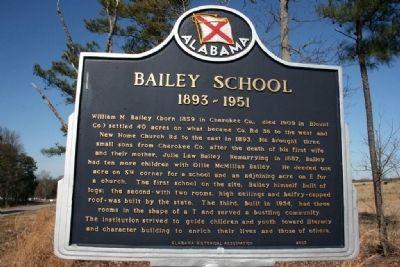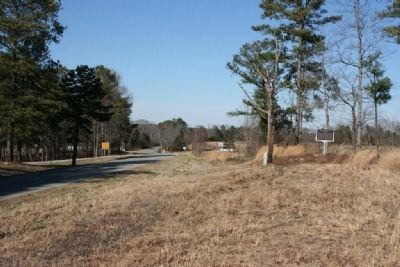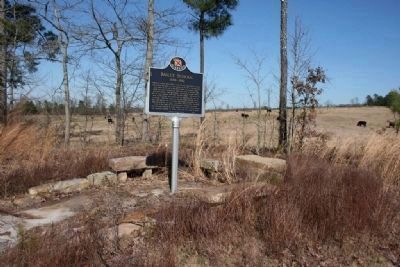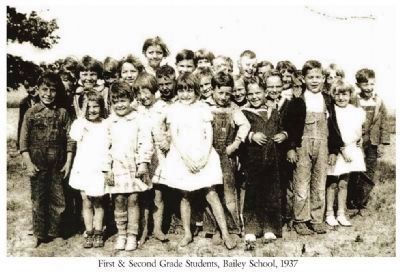Near Oneonta in Blount County, Alabama — The American South (East South Central)
Bailey School
1893 - 1951
Erected 2003 by Alabama Historical Association.
Topics and series. This historical marker is listed in these topic lists: Churches & Religion • Education • Settlements & Settlers. In addition, it is included in the Alabama Historical Association series list. A significant historical year for this entry is 1859.
Location. 34° 2.807′ N, 86° 24.41′ W. Marker is near Oneonta, Alabama, in Blount County. Marker is on County Road 36, 0.1 miles north of New Home Church Road, on the right when traveling north. Touch for map. Marker is at or near this postal address: 3572 County Rd 36, Oneonta AL 35121, United States of America. Touch for directions.
Other nearby markers. At least 8 other markers are within 9 miles of this marker, measured as the crow flies. Town of Susan Moore (approx. 2˝ miles away); Exploit of Murphree Sisters (approx. 5.1 miles away); Battle Royal (approx. 5.1 miles away); Antioch Cemetery (approx. 7 miles away); Blount County (approx. 7.9 miles away); Champion Mines (approx. 8 miles away); Welcome to Oneonta (approx. 8.1 miles away); Historic Oneonta L & N Railroad Depot (approx. 8.1 miles away). Touch for a list and map of all markers in Oneonta.
More about this marker. The original application to the Alabama Historical Association co-written by two of William M. Bailey's granddaughters, Orlene Bailey Clayton (who taught at the school and was 92 when the application was submitted) and Herstene Bailey Tidmore, and a great-great grandson, Johnny Tidmore, Esq., included more information about Bailey School and the community surrounding it. In her day, Orlene Clayton wrote a book on the area's history and fancied herself a storyteller, as is evidenced by the text.
The full text of the site's history for the marker application follows:
William M. Bailey, who was born in Cherokee County, Alabama in 1859 and died in Blount County, Alabama, in 1909, is buried in Wynnville cemetery. His wife, Julie Law Bailey, died in Cherokee County and left him with three very young sons: Porter Lee, Proncey David, and Pinkney Hezekiah. He then followed his parents, Jim Hezekiah and Rachel J. Bailey, and three sisters to Sand Valley with the typical early Americans ever moving westward. William's father, Jim, was one of the first to be buried at Lebanon Church cemetery on Blount County Road 42. One of William's sisters, Eliza, married Pink Amberson who was the son of John D. Amberson, the donor of four acres of land for the cemetery.
All of the land having being settled in the valley, William went up on "The Bluff," which is where one part of Sand Mountain's plains and rolling hills end, to find property for his own family. He then married Ollie McMillian and entered forty acres of land. He deeded one acre on the southwest comer for a school and one adjoining acre to the east for a church on what is today's Blount County Road 36 and New Home Church Number 1 Road.
In order to attend school, William's sons having to walk two miles from their home to the Mount Moriah church, he recognized the need for a school nearer home. So he donated the logs and built a log building for a school. On that site, the state later built a two-room building (date cannot be verified) with a high-gabled roof and belfry with a sweet-toned bell. The two rooms had coal-fired stoves, a stage for drama and recitations, and blackboards.
The school served students for an area of two square miles from the east down in the valley below Reid's Gap and up a winding trail beside the rocky road, between massive rocks of the foothills of the Appalachian Mountains, "Ike's Kitchen" on the north and the "Natural Bridge" to the south which were formed eons ago when the earth stopped shaking.
Children then came down hills westward for a mile or more in springtime under a canopy of blossoms surrounded on the ground by nature's own garden of wild Easter lilies, "rooster heads" (violets), blood root, and so forth, which existed before man came. The warm colors of fall and forests of giant, virgin hardwoods and underbrush, some loaded with berries and nuts, gave some protection from winter's harshest winter winds, as they walked, plod or ran until their arrival at school before that eight o'clock bell rang. There were similar scenes for the children from the northerly and southerly directions.
The third school building, a junior high, was built in 1934. The building was T-shaped with three rooms and served a very bustling community.
This institution served three generations of the founder's descendants and many other of the community's founding fathers.
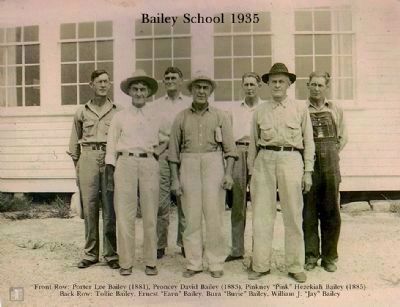
4. Sons of William Monroe Bailey, who built Bailey School, standing in front of Bailey School in 1935
The men on the front row in this photo (Porter, Proncey and Pink) were the sons of William Monroe Bailey's first wife Julia R. "Julie" Law Bailey (1862-1886).
The men on the back row (Tollie, Earn, Burie and Jay) were the sons of William Monroe Bailey's second wife Ollie J. McMillan Bailey (1871-1934).
The men on the back row (Tollie, Earn, Burie and Jay) were the sons of William Monroe Bailey's second wife Ollie J. McMillan Bailey (1871-1934).
From pioneering days through The Great Depression, World Wars I & II, our citizens saw it all. When the principal Mrs. Armindie Murphree's husband arrived home from World War I, she jumped into his arms. School let out for a while for the children to rejoice with them. The depression humbled everyone. It was pathetic--families ate just what they were able to grow on farms and in gardens.
Then came World War II. Many boys and men were drafted, and many from the community volunteered to serve the democracy and establish it in some aggressive countries. The community's women fell right in to replace the men in industry, heads of families, and in hospitals, all while those in the homes were knitting socks and sweaters for the men who had gone to war. Again, they willingly went through rationing of sugar, oil, tires, gasoline, coffee and tea so that the military could do the fighting. Artillery, uniforms, ammunition, food, medications and bandages were for the community's men in uniform. From our Atlantic shores on the east to the islands and continent of Europe, they fought. From our western shores on the Pacific to Hawaii, Midway, Tarawa, Iwo Jima, the Philippines, Guam, Okinawa, all the way to Australia, then Japan itself. So many thousands of men were lost. In fact, some of our community's own made the supreme sacrifice. At least one of the school's former students went down on D-Day either in the English Channel or on Normandy beach.
Thus, to honor Bailey School's founder and all other pioneers and those who followed making up this community until consolidation closed the school in 1951, we leave this token of our gratitude at this site.
Credits. This page was last revised on June 16, 2016. It was originally submitted on March 7, 2010, by Timothy Carr of Birmingham, Alabama. This page has been viewed 2,917 times since then and 68 times this year. Last updated on May 21, 2011, by Johnny Tidmore of Arab, Alabama. Photos: 1, 2, 3. submitted on March 7, 2010, by Timothy Carr of Birmingham, Alabama. 4, 5. submitted on May 21, 2011, by Johnny Tidmore of Arab, Alabama. • Kevin W. was the editor who published this page.
